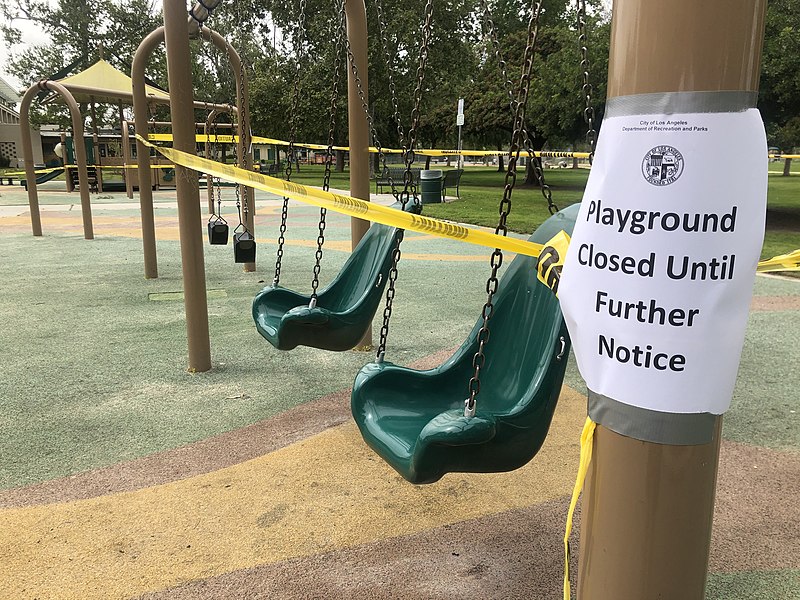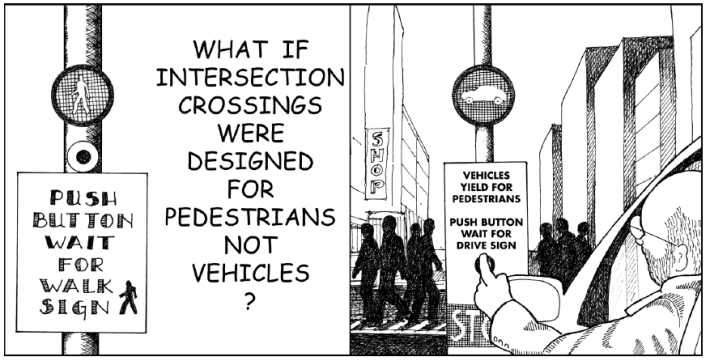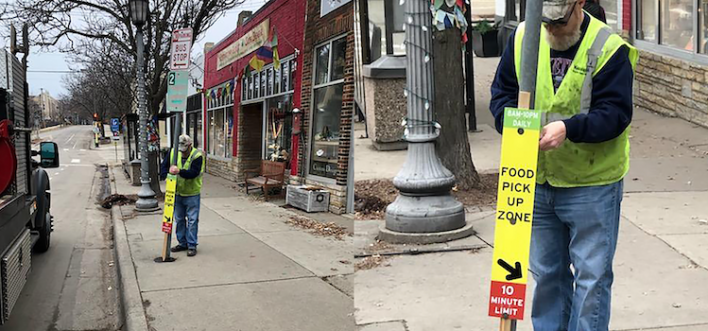Ten Ways Every City Should Respond to COVID-19 On Its Streets, Compiled by NACTO
12:01 AM EDT on March 31, 2020

Source: Wikimedia Commons.
The federal government has yet to issue real guidance on how to keep pedestrians and cyclists safe during the unprecedented challenges of COVID19 — so cities are stepping up and sharing resources themselves.
The National Association of City Transportation Officials just released an evolving toolkit of 22 emergency response strategies designed to protect road users and keep the world moving during our national emergency, along with a slate of webinars and other tools to make sure city leaders can successfully implement the best ideas. It's not a comprehensive list; because NACTO understands the way that city leaders think — and because the COVID-19 situation is constantly evolving — the organization has limited its endorsements to strategies that other member cities are already trying, which excludes some bolder steps that advocates believe should we be taking right now. But it's a start, and the group promises to regularly update the database as cities think begin to think bigger.
Especially in the absence of strong guidelines from the federal Department of Transportation, which has offered virtually no recommendations on how to protect vulnerable road users who are facing new risks during the COVID-19 outbreak, NACTO's list is one of the only resources available to cities who want to do better. And in this unprecedented time, advocates would be wise to not just pressure the Fed to encourage strategies like the ones NACTO is spotlighting, but to pressure the White House to give cities emergency funding to implement these crucial procedures where necessary.
Until that happens, here are 10 of the most important strategies in the toolkit — and our thoughts on what's missing.
1. 'Establish back-door boarding and waive fares to alleviate crowding and for operator safety'
This one might seem like a no-brainer to Streetsblog readers — but in much of America, it's still a controversial policy that needs serious advocate support right now. Fare collection on buses endangers the public transit drivers we need to get Americans without other transportation options to work and essential services — and in case you forgot, we were in the midst of an exciting national conversation about making many transit systems fare-free anyway right before the virus hit. There's no better time than now to robustly fund public transportation in other ways so it never needs to be fare-dependent again – and so no driver has to expose him or herself to COVID-19 in the line of work.
2. 'Build pop-up bike lanes'
NACTO could only cite two extremely limited temporary bike lane projects in New York City as a precedent for this strategy, and that's an incredible shame. Pop-up bike lanes — especially when they're protected, and when there is a comprehensive network of them — are among the cheapest and most effective ways to protect cyclists and pedestrians from car traffic, with the added benefit of slowing down drivers so they're less lethal to one another, too. Bogota built 47 miles of pop-up bike lanes nearly overnight. Every city in America should be thinking that big, especially to encourage sustainable, socially-distant transportation and relieve crowds on whatever transit remains for emergency workers.
3. 'Classify bike shops as essential services'
As we've documented heavily on Streetsblog, advocates from coast to coast have had to fight tooth and nail to maintain access to bike mechanic services during citywide shelter in place orders — even though the bike is about the only way that former transit riders with longer commutes can safely get to work without a car. As we potentially tighten strictures in the coming weeks, advocate should have to fight that battle again — and cities should probably start talking about deploying government-funded mobile bike shops to complement the brick-and-mortar services.
#Socialdistancing bike repair: @bikerescuenyc full service van came right to my front door to replace my worn out freewheel, chain, and rear brakes. And they we really good about practicing sanitation. Wiped down my bike and everything!
— Courtney Williams (@BrownBikeGirl) March 30, 2020
Hit em up #bikenyc pic.twitter.com/D5MJLscmlY
4. 'Offer free or reduced bike share access'
Pretty much as soon as COVID-19 hit, a fast-motion debate about whether or not bikeshare was safe during a pandemic unfolded. The cities who got it right, like Chicago and DC, not only decided that micromobility matters now more than ever, but expanded access to low-income people and offered free rides to healthcare workers while increasing sanitization procedures. We're with NACTO on this one, but we'd add this: scooter share, moped share, and other micromobility options (such as Revel making its fleet available to heath care workers) should be stepping up, too, and cities should be working with the private companies they allow on their streets to make sure the fleets stay running. (And the private companies definitely shouldn't be pulling their fleets, but we digress...)
5. 'Convert actuated to fixed signals where possible'
Here's another simple, low-cost and totally essential ideas that hasn't gotten nearly enough press: reprogramming pedestrian crosswalks so no one has to touch a potentially contaminated "beg" button to get something as simple as a "walk" signal. It's not the kind of thing that cities put out press releases about, but both Brookline and Cambridge, Mass. have reportedly done it, as has the city of Asheville, N.C. We need to make walk signals automatic everywhere, and put up signage so citizens know they don't have to potentially expose themselves to disease to legally cross the street.
Frankly: beg buttons probably shouldn't exist in the first place, and this would be a heck of a good moment to get rid of them so walkers don't have to request the privilege of using public space, just like drivers. And while we're at it, it'd be a great time to program in some generous leading pedestrian intervals at every intersection where people regularly walk.

6. 'Establish dedicated delivery/loading zones for restaurants, commercial businesses and school lunch pick up'
The amount of land and money our cities devote to street parking is unconscionable in the best of times — and it's madness during a national emergency. One small way to put that land to better use is to institute strict limits on parking outside restaurants and retail businesses, so cars can only stay there for the time it takes for an employee to run a carryout order to your passenger's side window. Minneapolis, Austin, and Seattle are just a few of the cities that have installed new signage at spots along major shopping and dining corridors.
Advocates in cities that have implemented this policy have noticed a happy (if accidental) upside, too: for the many, many hours a day that curbside pick up spots sit empty, pedestrians are using the area to get a little more social distance from one another. City leaders that are really smart would add signage to make it clear that walkers are always welcome to use empty parking spaces as an extension of the sidewalk, and make sure sight lines are clear for drivers who might pull in.

7. 'Close streets that go through parks'
Hey, has anyone read this visited a park in an even moderately populous city lately? It is kind of insane how crowded they are compared to your typical spring day, right? The least we could do is stop cars from driving straight through them, so we can all use that extra space for much-needed outdoor fun while maintaining our social distance.
Unfortunately, the cities who are doing this are mostly only doing it in a limited capacity: Philadelphia closed a single street that runs through a park but left others open, Minneapolis closed just a few sections of the streets near its riverfront parkways, and there are other examples here and there. But truly smart cities would cool it with the piecemeal approach to pedestrian safety and start closing all parks to car traffic for which there is an alternative route.
8. 'Use Open Streets/Ciclovia routes to create more space'
Here's another strategy that, so far, has been better on paper than it could be in reality: closing streets outside parks to car traffic so walkers can spread out. New York City proudly announced that it was implementing an Open Streets plan, then proceeded to put on a tiny handful of glorified block parties that were over-policed, way too brief, and — oh yeah — still allowed cars to cut through select points on the route.
If we want to get through this pandemic, we don't just need more Open Streets events — we need good Open Streets policies that are practical, meaningful, and accessible to all residents (hint: not everyone considers chilling in the street with twenty cops to be a relaxing time.) Streetsblog will be reporting more on how experts think cities can repurpose the Open Streets model in the age of COVID-19; follow the hashtag #COVIDSafeStreets to read it the moment it drops.
9. 'Adjust signal timing to slow vehicles'
Reprogramming traffic lights to slow down cars isn't a cure all — and it definitely works best in an urban context with short blocks — but it's a start. New York City is currently expanding a 2019 signalization program designed to make the city more bikeable to meet the new challenges of the coronavirus age.
But if cities think that reprogramming signals is all it'll take to slow down drivers who are living out their post-apocalyptic drag racing fantasies right now, they're wrong. There are countless things cities can do to slow down cars, from lowering speed limits to instituting quick-build road diets to physically deter drivers from hitting the gas while there's less traffic to contend with.
10. 'Use city/government property to open testing locations accessible to people outside cars'
Today in "Duh, Not Everyone Drives," drive-through COVID-19 testing is inherently inequitable, especially if the only alternative is a crowded hospital full of the confirmed sick. Most Americans have enough barriers to getting a COVID-19 test right now; not owning a car shouldn't be one of them.
We'd add one caveat to NACTO's recommendation: COVID-19 tests should be available in the socially-distanced outdoors. Muncie, Ind., Detroit, Mich., and Memphis, Tenn. are just a handful of the cities who have put up field hospitals in literal fields in the form of medical tents, a set-up that allows crews to more easily sanitize testing sites at the end of the day.
Kea Wilson has more than a dozen years experience as a writer telling emotional, urgent and actionable stories that motivate average Americans to get involved in making their cities better places. She is also a novelist, cyclist, and affordable housing advocate. She previously worked at Strong Towns, and currently lives in St. Louis, MO. Kea can be reached at kea@streetsblog.org or on Twitter @streetsblogkea. Please reach out to her with tips and submissions.
Read More:
Stay in touch
Sign up for our free newsletter
More from Streetsblog USA
Friday’s Headlines Are Down on Highways
Two outlets recently featured articles on the harmful effects of ongoing freeway projects.
Commentary: There is Zero Ambiguity to the West Portal Tragedy
What happened in West Portal was entirely predictable and preventable. The city must now close Ulloa to through traffic and make sure it can never happen again.
Talking Headways Podcast: Details of Development Reform in Minnesota, Part I
Jim Kumon of Electric Housing discusses his work as a developer and urban policy educator in the Twin Cities.
Thursday’s Headlines Don’t Like Riding on the Passenger Side
Can you take me to the store, and then the bank? I've got five dollars you can put in the tank.
Study: When Speed Limits Rise on Interstates, So Do Crash Hot Spots on Nearby Roads
Rising interstate speeds don't just make roads deadlier for people who drive on them — and local decision makers need to be prepared.




